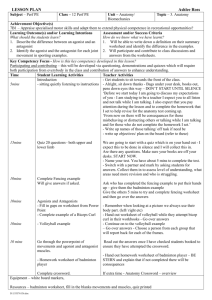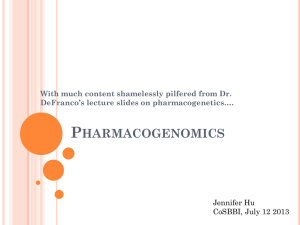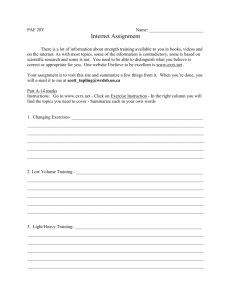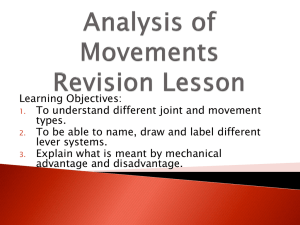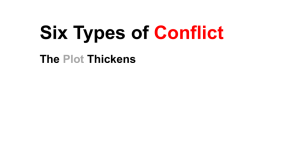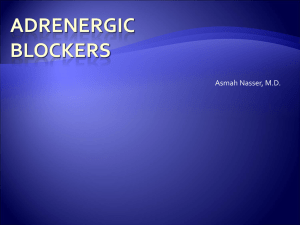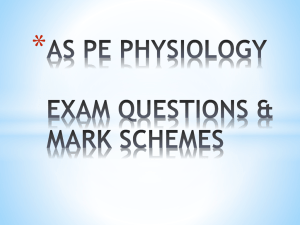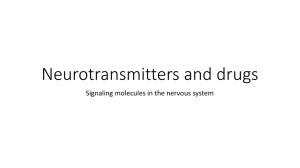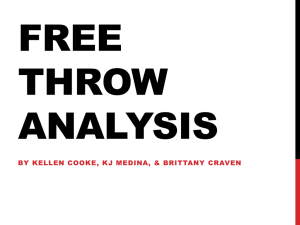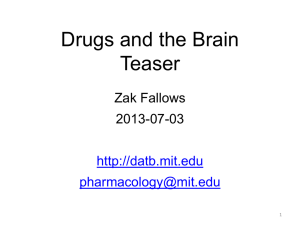Muscle System - Coop Group Action - Day 9
advertisement
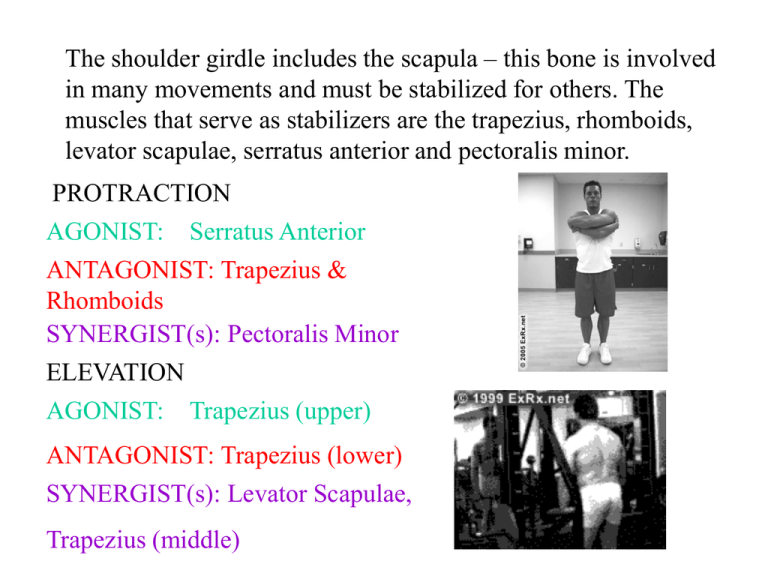
The shoulder girdle includes the scapula – this bone is involved in many movements and must be stabilized for others. The muscles that serve as stabilizers are the trapezius, rhomboids, levator scapulae, serratus anterior and pectoralis minor. PROTRACTION AGONIST: Serratus Anterior ANTAGONIST: Trapezius & Rhomboids SYNERGIST(s): Pectoralis Minor ELEVATION AGONIST: Trapezius (upper) ANTAGONIST: Trapezius (lower) SYNERGIST(s): Levator Scapulae, Trapezius (middle) The SITS muscles comprise what we call the ‘rotator cuff’. Although involved in rotation of the humerus (& abduction in the case of the supraspinatus), they are primarily stabilizers of the shoulder joint, holding the humerus in the glenoid fossa. One example is internal rotation with the suscapularis as one of the synergists to the the latissimus dorsi (agonist). Another role of synergists is played by the wrist flexors as they hold a 2nd joint from moving while the desired action takes place. External rotation is achieved by the posterior deltoid with the infraspinatus, teres minor & the latissimus dorsi as synergists. Again, the wrist muscles (extensors) play the role of stabilizers. SHOULDER ADDUCTION AGONIST: Latissimus Dorsi ANTAGONIST: Lateral Deltoid SYNERGIST(s): Pectoralis Major, Teres Major, Coracobrahialis NOTE: The scapula must complete downward rotation during this movement, involving the rhomboids SHOULDER ABDUCTION AGONIST: Lateral Deltoid ANTAGONIST: Latissimus Dorsi SYNERGIST(s): Supraspinatus NOTE: The scapula must complete upward rotation during this movement, involving the trapezius & pectoralis minor muscles SHOULDER FLEXION AGONIST: Anterior Deltoid ANTAGONIST: Posterior Deltoid SYNERGIST(s): Biceps Brachii (short head), Pectoralis Major, Coracobrachalis NOTE: Flexion of the shoulder occurs in the sagittal plane, around the transverse axis SHOULDER EXTENSION AGONIST: Posterior Deltoid ANTAGONIST: Anterior Deltoid Pectoralis Major SYNERGIST(s): Latissimus Dorsi, Teres Major, Triceps Brachii (long head) NOTE: Extension of the shoulder also occurs in the sagittal plane, around the transverse axis ELBOW FLEXION AGONIST: Biceps Brachii is the prime mover. ANTAGONIST: Triceps Brachii SYNERGIST(s): Brachialis, Brachioradialis, Pronator Teres Distal & proximal radio-ulnar joints allow the forearm to turn in order to do many of the fine motor & sport-related movements of the hand I.e. Pronation and supination as the radius rolls over the ulna through the transverse plane around the longitudinal axis. SUPINATION is achieved by the biceps brachii with the supinator as synergist. PRONATION is achieved by the pronator teres & quadratus together with no real synergist. The pelvic girdle includes the pelvic bones– 3 fused bones that stabilize the hip joint for weight bearing. It is further stabilized by the deep lateral rotator muscles that play the same role as the rotator cuff does in the pectoral girdle – synergists as they stabilize the hip joint and help rotate the femur HIP FLEXION AGONIST: Iliopsoas is 2 muscles with powerful origin & insertion on the lumbar vertebrae, pelvic bone & greater trochanter of the femur NOTES: The only quadricep muscle that acts on the hip is the rectus Gluteus Maximus or femoris; the AGONIST in HIP Hamstring Group EXTENSION depends on the intensity of the action ~ in walking SYNERGIST(s): the hamstrings do most of the work; Rectus Femoris, Sartorius, in running or climbing stairs the gluteus maximus is the agonist. Tensor Fasciae Latae ANTAGONIST: HIP ABDUCTION AGONIST: Gluteus medius ANTAGONIST: Adductor Group SYNERGIST(s): Tensor Fasciae Latae, Gluteus Minimus NOTE: Abduction & adduction occur through the frontal plane, around the AP axis KNEE FLEXION AGONIST: HAMSTRINGS Semimembranosus, Semitendinosus, Biceps Femoris ANTAGONIST: QUADRICEPS Rectus Femoris, Vastus Lateralis, Vastus Intermedius, Vastus Medialis SYNERGIST(s): Gastrocnemius, gracilis, sartorius NOTE: In the opposing action (knee extension) the only muscle(s) doing the action is the quad group. There is no synergist. PLANTAR FLEXION AGONIST: Gastrocnemius ANTAGONIST: Tibialis Anterior SYNERGIST(s): Tibialis Posterior, soleus NOTE: What looks like extension of the ankle is plantar flexion ~ moving the toes & knees closer is dorsi-flexion, with the Tibialis Anterior as AGONIST.
